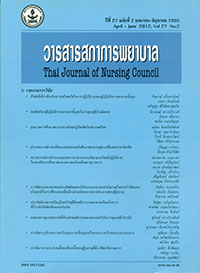การจัดการอาการปวดเมื่อยกล้ามเนื้อของผู้สูงอายุที่มีอาชีพกรีดยางพารา
Keywords:
การจัดการอาการปวด, ผู้สูงอายุที่มีอาชีพกรีดยางพารา, management of muscular aches and pains, old-age rubber tappersAbstract
บทคัดย่อ
การวิจัยเชิงบรรยายนี้มีวัตถุประสงค์เพื่อศึกษาประสบการณ์อาการปวดเมื่อย กล้ามเนื้อ การจัดการกับอาการปวด และผลลัพธ์ในการจัดการกับอาการปวดของผู้สูงอายุ ที่มีอาชีพกรีดยางพารา กลุ่มตัวอย่างในการศึกษานี้เป็นผู้สูงอายุที่มีอาชีพกรีดยางพารา 152 คน ในอำเภอแห่งหนึ่งของภาคใต้ เก็บรวบรวมข้อมูลโดยใช้แบบสอบถาม ประกอบด้วย 3 ส่วน 1) แบบสอบถามข้อมูลส่วนบุคคล 2) แบบประเมินความปวดมาตรฐาน และ 3) แบบสอบถามการจัดการอาการปวดเมื่อยกล้ามเนื้อ วิเคราะห์ข้อมูลโดยใช้สถิติความถี่ ร้อยละ ค่าเฉลี่ย ส่วนเบี่ยงเบนมาตรฐาน
ผลการศึกษาประสบการณ์อาการปวดเมื่อยกล้ามเนื้อของผู้สูงอายุที่มีอาชีพกรีด ยางพาราในช่วง 1 เดือนที่ผ่านมา พบว่า มีความปวดอยู่ในระดับปานกลาง (M = 6.09, SD = 1.63) และระดับเล็กน้อย (M = 3.04, SD = 1.92) ความปวดโดยรวมเฉลี่ยอยู่ใน ระดับเล็กน้อย (M = 4.18, SD = 1.61) และความปวดขณะที่ประเมินอยู่ในระดับเล็กน้อย (M = 3.20, SD = 2.07) เช่นกัน นอกจากนี้ยังพบว่าอาการปวดเมื่อยกล้ามเนื้อได้ส่งผล กระทบต่อการดำเนินชีวิตในมิติด้านพฤติกรรมมากที่สุดโดยมีค่าเฉลี่ยของผลกระทบใน ระดับเล็กน้อย (M = 2.12, SD = 1.60) การจัดการอาการปวดเมื่อยกล้ามเนื้อที่ใช้มีทั้งวิธี ใช้ยาและไม่ใช้ยา โดยวิธีที่เลือกใช้มากที่สุด 3 อันดับแรก คือ การใช้ยาแก้ปวด (ร้อยละ 62.50) การนอนพัก นั่งพัก (ร้อยละ 59.87) และการใช้ยาสมุนไพร (ร้อยละ 50.66) ผลลัพธ์ของการจัดการอาการปวดโดย 3 วิธีดังกล่าวทำให้ระดับความรุนแรงของอาการลดลง อยู่ในระดับเล็กน้อย
ผลการศึกษาในครั้งนี้สามารถนำไปเป็นข้อมูลพื้นฐานสำหรับบุคลากรทางด้านสุขภาพ ที่มีส่วนในการดูแลผู้สูงอายุที่ประกอบอาชีพกรีดยางพาราในการส่งเสริมการจัดการอาการ ปวดเมื่อยกล้ามเนื้อให้มีประสิทธิภาพมากขึ้น
คำสำคัญ : การจัดการอาการปวด, ผู้สูงอายุที่มีอาชีพกรีดยางพารา
Abstract
The main objective of this descriptive research project was to study conditions of muscular aches and pains experienced by old-age rubber tappers, as well as their management of such aches and pains and its outcomes. The sample population consisted of 152 old-age rubber tappers in a Southern Thailand district. The data were collected through a questionnaire consisting of three sections: (i) the personal profile section; (ii) the standard ache and pain evaluation section; and (iii) the muscular ache and pain management section. The data were analysed statistically in terms of frequency, mean, percentage and standard deviation.
The research revealed that the majority of the sample subjects had during the previous month been suffering from mild (M = 3.04, SD = 1.92) to moderate (M = 6.09, SD = 1.63) muscular aches and pains. The sample population’s average intensity of aches and pains was identified as mild (M = 4.18, SD = 1.61); so was their level of aches and pains at the time of the survey (M = 3.20, SD = 2.07). In addition, muscular aches and pains were reported by the subjects as most strongly affecting the behavioural aspect of their lives, but such effects were mild (M = 2.12, SD = 1.60). To manage muscular aches and pains, the sample subjects relied on both medication and other methods, the three most commonly adopted solutions being applying analgesic cream (62.50%), sitting or lying down to rest (59.87%) and taking herbal medicines (50.66%). Application of these pain management methods only slightly reduced the intensity of their aches and pains.
The outcomes of this study could serve as basic data for healthcare personnel caring for old-age rubber tappers. The data could be applied to the promotion of more effective means of muscular ache and pain management.
Keywords : management of muscular aches and pains, old-age rubber tappers







